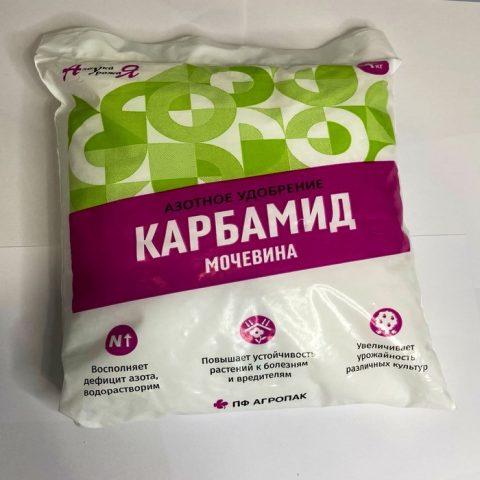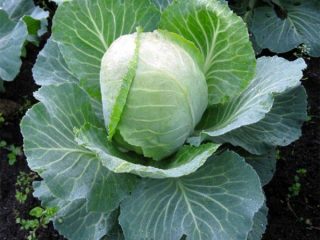Content
It is impossible to get a good harvest of cabbage without fertilizing (this applies to any variety). One of the “basic” macroelements needed by plants is nitrogen. Its source most often is mineral fertilizers, in particular urea. However, excess nitrogen provides the opposite of the desired result, so you need to know how to prepare a working solution, when is the best time to feed cabbage with urea and how exactly to apply the fertilizer.
Does cabbage like urea?
Urea (aka urea) is a highly concentrated mineral “mono-fertilizer” containing 46% nitrogen in a form easily absorbed by plants. Available in the form of white, odorless granules, easily soluble in water.
Cabbage reacts negatively to an excess of nitrogen in the soil. But in the right concentration, it is a “growth activator” for her, stimulating the process of growing green mass.

Urea is a universal fertilizer, suitable not only for cabbage, but also for any other garden crop.
Without this, tying and forming heads of cabbage will be impossible in the future.Therefore, fertilizing with urea soon after transplanting into soil for seedlings is extremely important and vital.
However, it is absolutely impossible to say that cabbage really “loves” urea and this is a suitable fertilizer for it throughout the season. If a gardener is overly zealous with fertilizing, the metabolic processes “go astray” and the plant begins to “fatten”. The leaves in such rosettes are very large, fleshy, and rich green in color. But they “refuse to form” heads of cabbage or they turn out to be very “loose”.

Proper fertilizing with urea or other nitrogen fertilizer at an early stage of development is the key to a good harvest at the end of the season.
The benefits of urea for cabbage
Urea is a very popular means for feeding cabbage among gardeners. This is due to the fact that when used correctly, fertilizer brings significant benefits to plants:
- Complex effect. Properly applied fertilizer not only has a beneficial effect on plants, but also improves the quality of the substrate. In the future, for the crops planted in this bed, this means accelerated growth and development, increased productivity.
- Improving plant resistance to many diseases even in the absence of “innate” immunity. Treatment reduces the risk of attack by aphids, stem weevils, and some other pests.

Feeding cabbage with urea is a kind of “contribution to the future” of the garden bed
Advantages and disadvantages
The fertilizer has many undoubted advantages:
- the presence of nitrogen in high concentration and easily absorbed by plants;
- “long-lasting” effect of soil enrichment with nitrogen;
- ensuring the desired result regardless of the quality and other characteristics of the substrate in the garden;
- the possibility of using urea for cabbage in the form of dry granules and solution, use as root and foliar feeding
- active growth of green mass;
- strengthening plant immunity, effective prevention of attacks by certain pests;
- beneficial effect on the volume and quality of the harvest;
- affordable price, availability of fertilizer in absolutely any gardening store.
Of course, there are also disadvantages:
- the impossibility of combining with other fertilizers with a similar effect in order to avoid oversaturation of the soil with nitrogen;
- cumulative effect;
- negative impact on the crop if used incorrectly (especially with regard to the frequency of application and concentration of the solution);
- need to be stored in tightly sealed packaging.

Excess nitrogen is no less harmful to plants than its deficiency.
Timing for fertilizing
Feeding cabbage seedlings with urea before transplanting into open ground is a risky endeavor. If you make a mistake with the concentration of the solution, the fertilizer can simply “burn” the fragile roots of the seedlings. Most gardeners do not recommend this procedure, but some still carry it out about a week after picking. And if it was not carried out - in the phase of 3-4 true leaves.
The optimal time for feeding cabbage with urea is 7-10 days after transplanting the seedlings to the garden bed.Next, you can add urea again when the head of cabbage is just beginning to set. It is included in complex feeding along with other “mono-fertilizers” containing potassium and phosphorus.
When growing mid-season and late varieties and hybrids, fertilizers are applied 3-4 times per season. Here, urea and other nitrogen-containing fertilizers are excluded; for the formation of heads of cabbage, potassium and phosphorus are needed in combination with a complex of microelements.

After the head has set, use fertilizers with little or no nitrogen content.
Preparation of solution and dosage
In principle, urea can be used in dry form to feed cabbage in May-June, especially if there are frequent and heavy rains in the spring. The granules are simply distributed around the stems and between the rows, embedded in the soil.
But in most cases, gardeners prefer to prepare liquid fertilizer. When root feeding cabbage with urea, the required proportion is 100 g of granules per 10 liters of water. To spray plants, take half as much.
Approximate fertilizer consumption rates are as follows:
- when preparing beds in autumn for planting next season - 5 liters of solution or 50 g of urea granules;
- for root feeding of seedlings after transplanting into the ground - 0.5-1 l;
- for spraying plants - about 200 ml.
It is extremely easy to prepare urea fertilizer for feeding cabbage. The granules dissolve quickly and without residue in water.Therefore, the required amount of urea is simply poured into a container and stirred for literally a minute. The only requirement is that the water must be settled or softened in some other way. Cabbage reacts very negatively to chlorine and fluorine compounds that enter the soil along with tap water.

Preparation of the working solution is literally a matter of minutes
How to use urea for cabbage
The only thing you shouldn’t do is simply scatter the granules over the garden bed. Here soil microorganisms are not able to “reach” them. When in contact with oxygen, urea is converted into ammonium carbonate in a few days, and it is converted into ammonia, which very quickly evaporates from the soil surface. Accordingly, the effect of such feeding will be minimal, or there will be none at all.
It is also necessary to take into account that urea is incompatible with any substrate “deoxidizers” used to normalize the pH of highly acidified soil. Products in this category include slaked lime, dolomite flour, calcium nitrate, crushed eggshells, and wood ash. As a result, an “explosive mixture” is formed in the literal sense of the word; cabbage most likely will not survive such “feeding”.
Fertilizing cabbage seedlings with urea
Some gardeners practice feeding cabbage seedlings with urea immediately at the time of planting on the ground, and not some time after that. A very small amount of fertilizer (2-3 g) is poured onto the bottom of the hole, “covering” it with a layer of substrate or humus, rotted compost about 1 cm thick. Otherwise, the roots of the seedlings receive “chemical burns”.
Important! It is best to carry out the necessary preparations the evening before transplanting the plants into the garden bed.
Root spraying
The most popular method among gardeners. This is due to the combination of its simplicity and effectiveness. You just need to prepare a solution and pour urea over the cabbage.
Fertilizers are applied directly to the roots. Drops of water falling on the leaves can cause burns and the appearance of areas of dead tissue.
To feed cabbage with urea after planting in the ground, choose a fairly warm, cloudy day. In extreme heat under direct sunlight, the solution quickly evaporates without having time to be absorbed into the ground. For the same reason, it is not recommended to apply fertilizer in the morning - the weather can change unpredictably during the day.

The root system of cabbage does not grow very actively in breadth, so it is recommended to “surround” the stems with an earthen rampart
Foliar treatment
Foliar fertilizing with urea is carried out if the appearance of the cabbage clearly indicates a nitrogen deficiency. Another possible reason for such treatment is to prevent attacks on plants by aphids or other pests.
Since the lowest leaves are the first to suffer when there is a lack of nitrogen, it is they and the base of the stem that are treated especially carefully. Spraying is carried out using a fine spray bottle. It is strictly forbidden to dip sheet plates into the solution or “rub” liquid into them.

The appearance of cabbage quite eloquently signals a lack of nitrogen and the need to fertilize with urea.
Conclusion
If you feed cabbage with urea on time and in the right proportion, this will provide it with nitrogen for the active growth of green mass, which is vital at an early stage of development. However, in the future, its excess is harmful to plants. Accordingly, when applying nitrogen fertilizers, only a solution of a certain concentration is used and cabbage is fertilized exclusively within the specified time frame.








